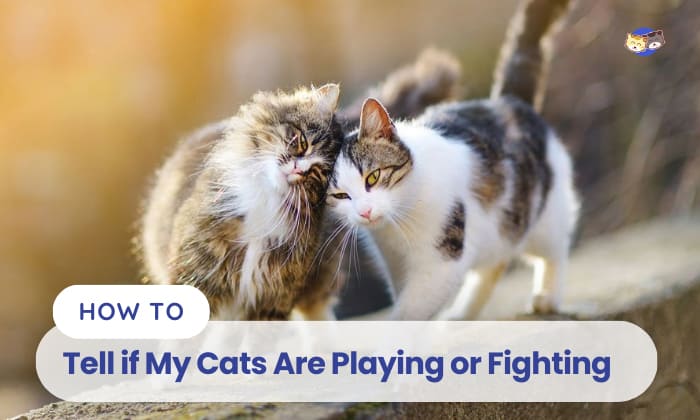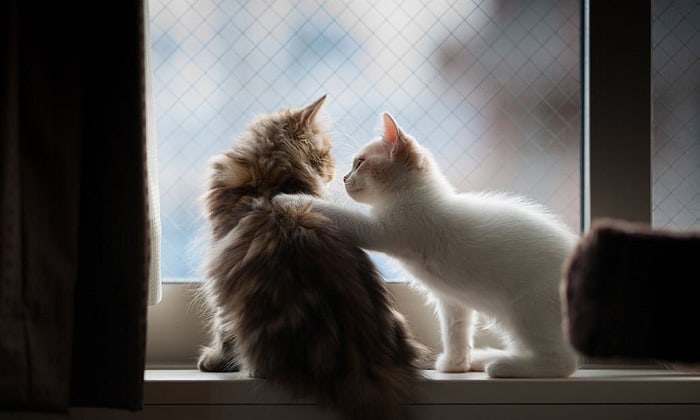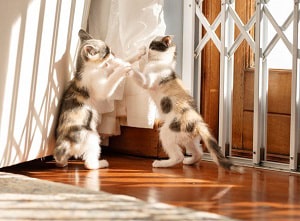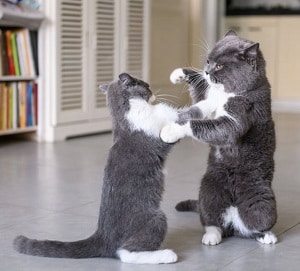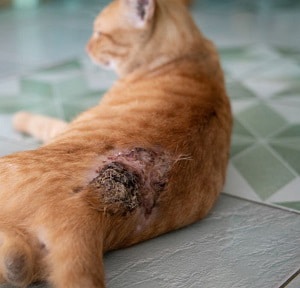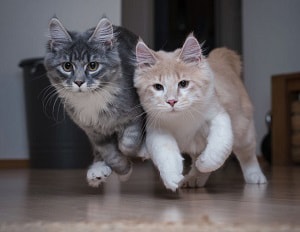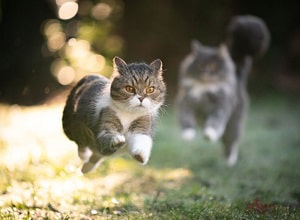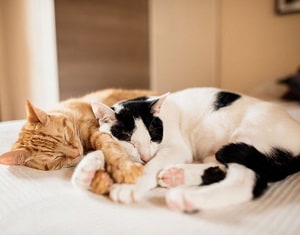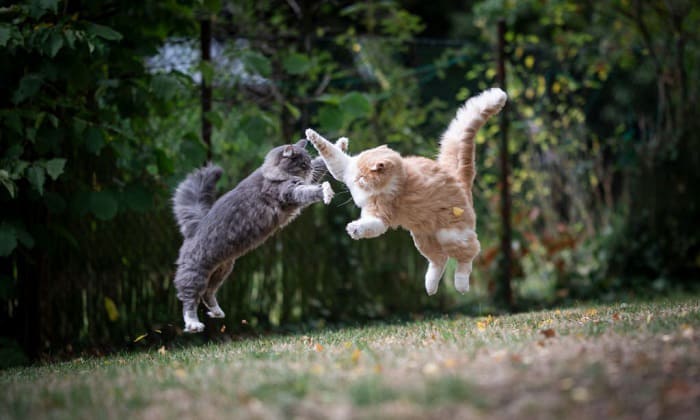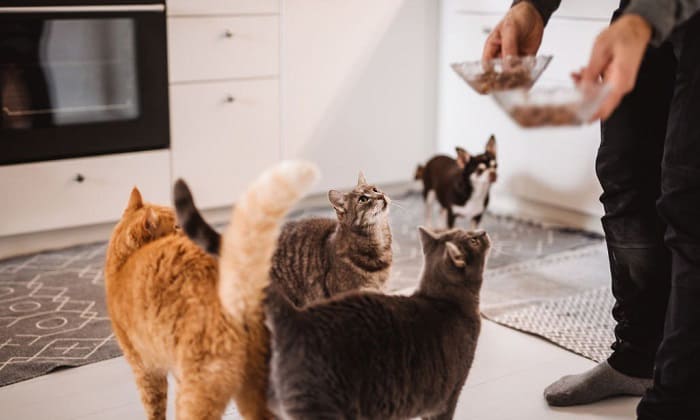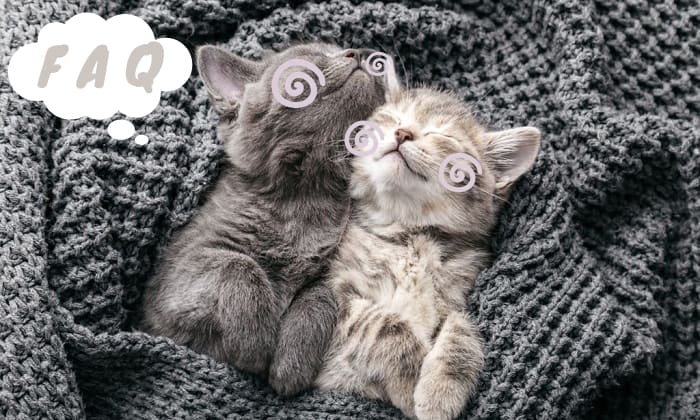How to tell if my cats are playing or fighting? A cat owner must know the difference between play and aggression, especially when two or more cats interact. While distinguishing between the two can be difficult, ensuring your cat’s safety and well-being is critical.
This guide will go over the behaviors and signs to look for to determine whether your cat is playing or fighting so you can decide whether to intervene or not.
Table of Contents
How to Know if My Cats Are Playing or Fighting?
You should pay attention to your cats’ body position, vocalizations, the speed and intensity of their movements, etc. Observing these behaviors lets you determine whether your cats engage in friendly play or an aggressive fight.
1. Watch their body position
Cats involved in a fight usually take a forward stance toward one another. When cats play with each other, they alternate between being on top of one another and rolling onto their sides or backs.
On the other hand, if you observe cats swiping at one another while leaning back, they may be engaged in a fight.
Moreover, cats tend to have fluid and relaxed body postures when playing, whereas they become rigid and tense during a fight.
2. Listen to your cats’ sounds
When cats participate in play fighting, they may appear calm and satisfied and normally make little noise while chasing and biting one another. Meowing is more common than hissing or growling at this time.
But, if you hear constant growling or hissing, it may be a sign that your cats are engaged in a serious battle instead of engaging in playful behavior. Observing your cats’ body language and behavior is vital to understand whether their interactions are friendly or aggressive.
3. Pay attention to the slight changes
Ears, claws, hair, and tails differ when the kittens are fighting or playing. Cats’ ears are often positioned forward, upright, or slightly backward in a mock fight. Yet, it’s a clear sign that they are fighting if you see their ears turned back or flattened against their head.
When cats are playing, they typically have flat hair, and their claws will be sheathed or pulled back. On the contrary, their tails are held low, and the fur on your cat’s tail, body, or both, may puff up if they are in a real fight. Cats can also hurt or damage other cats by using their claws on them.
4. Observe for biting and scratching
When playing, biting is often light and does not result in any injuries. But, if one of the cats hisses, growls, or yowls in agony, it’s conceivable that they’re engaged in combat.
Sometimes it is difficult to tell whether your cats are playing or fighting with you. Are cats wrestling when they are engaged in play behavior? The answer is yes. Cats sometimes kick with their hind legs and bite you lightly while playing with you.
5. Take turns
Cats engaged in play may alternate between chasing, grinding, and licking each other. So, if they appear to be fighting immediately after, it is most likely play-fighting, and they are not in attack mode.
When playing, cats both chase one another. On the other hand, a cat engaged in combat will either try to escape the more aggressive cat by running away or continuing to fight to defend itself.
6. Observe the pace and speed of the fight
Cats may stop and start several times during a playing session; they usually keep going steadily, mostly calmly. However, if the fighting gets worse and more chaotic, it may indicate that the situation is becoming out of control. Cats move quickly and do not stop until one is declared the winner.
7. Examine their daily behavior towards each other
If they sleep and cuddle next to each other, groom each other, and like rubbing against each other, they are probably friends.
But there may be tension between cats if they keep a safe distance from each other when eating, drinking, sleeping, or using the litter box. They avoid each other, rest in separate regions, and try to cut off their access to resources before resorting to the other’s methods.
Reasons for Fighting Among Cats
Cats can fight each other for a variety of reasons, including:
- Territory: Cats are territorial animals and will fight to defend their territory against other cats they perceive as threatening.
- Resources: Cats may fight over food, water, litter boxes, and toys. This can occur if there aren’t enough resources or if one cat is overly possessive of a specific resource.
- Dominance: Cats are a hierarchical species that will fight to establish dominance over one another. This is especially prevalent in male cats who have not been neutered.
- Fear: Fear can cause cats to fight, especially if they feel threatened or cornered by another cat.
- Aggression: Some cats have more aggressive personalities and are more likely to initiate fights with other cats.
- Illness or pain: When a cat is ill or in pain, he or she may become irritable and more likely to fight with other cats.
Tips to Get Cats to Get Along
You can do several things to help your cats learn to coexist peacefully if they don’t get along. Here are some tips:
- Introduce them gradually: It’s important to introduce cats slowly when putting them together for the first time. Start by putting them in different rooms and letting them sniff each other through a closed door.
Then, let them spend more and more time together under your watchful eye until they are comfortable with each other.
- Use positive reinforcement: When your cats are getting along, give them treats, toys, and praise. This will help them associate good behavior with positive outcomes.
- Play together: Playing with your cats helps them bond and learn to trust one another. Use interactive toys such as wand toys or laser pointers to encourage play.
Ways to Prevent and stop Fighting in Cats
Fighting between cats is a common issue that can be stressful for the cats and their owners. Here are some methods for preventing cats from fighting:
- Provide plenty of resources: Ensure each cat has food, water, a litter box, and toys, so they don’t have to fight over resources.
- Give them their space: Cats enjoy having personal areas where they may hide and feel safe. Provide each cat space in various hiding places throughout the house, such as cardboard boxes, cat trees, or soft blankets.
- Neuter or spay your cats: Not neutered cats are more likely to be aggressive. Spaying or neutering your cats can help to reduce territorial instincts and avoid fights.
- Establish a routine: Cats prefer consistency and routine. Establish a feeding and playtime schedule for your cats to ease tension and prevent conflicts.
- Clap loudly and use water spray: In case your cats are in a fight, clap your hands loudly to alert them to stop. If they don’t, you can use a water spray bottle to spray at them.
Frequently Asked Questions
Why Do Cats Playing Look Like They Are Fighting?
Cats play fighting too rough with other cats as a natural form of play and socialization. Cats will wrestle, pounce, and bat at each other with their paws during play fighting.
While this may appear aggressive to humans, it is a normal and healthy form of cat play. Play fighting allows cats to hone their hunting and fighting skills while forming social bonds with other cats.
How Do You Know If Your Cats Are Getting Along?
There are a few indicators that your cats are getting along:
- The cats are at ease sleeping or lounging next to each other.
- The cats occasionally groom each other.
- They have fun chasing each other or wrestling with each other.
- They enjoy eating next to one another.
- There are no signs of tension or aggression.
If you notice any signs of tension or aggression, such as hissing, growling, or fighting, you should intervene and try to determine the source of the conflict.
Why Are Cats Chasing Each Other at Night?
Cats chasing each other are playing or fighting? Well, cats are usually more active at night than during the day so they may chase each other at night. Even when they live inside, cats naturally tend to track things. It could help them eliminate boredom or play with each other.
It could also be a sign of a territorial or dominance problem, but most of the time, cats playing and chasing each other is harmless and common, especially at night when they are more active.
Conclusion
Ultimately, cat owners must know whether their cat and kitten are playing or fighting. While playing is normal and healthy for cats, fighting can be dangerous and lead to injuries.
“How to tell if my cats are playing or fighting?” is not a hard question. Cat owners can tell the difference between play and aggression by watching their cats’ body language and actions. By paying attention and giving cats a safe and comfortable place to play, cat owners can ensure they live in a peaceful and happy home.

I pursued veterinary studies at the University of Kansas. After several years of practice, I established a veterinary clinic in Kansas. When Michael extended an invitation with a vision that went beyond emergency support – sharing of caregiving information for guardians to create the best living environment for cats, I didn’t hesitate to join the organization.
My role here involves verifying the information presented on the official website. With my experience, I believe the information provided is entirely accurate. If you have any concerns, please feel free to reach out to me


